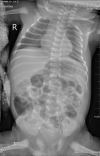Delayed cardiac tamponade diagnosed by point-of-care ultrasound in a neonate after peripherally inserted central catheter placement: A case report
- PMID: 33553397
- PMCID: PMC7829730
- DOI: 10.12998/wjcc.v9.i3.602
Delayed cardiac tamponade diagnosed by point-of-care ultrasound in a neonate after peripherally inserted central catheter placement: A case report
Abstract
Background: Peripherally inserted central catheters (PICCs) have been increasingly applied worldwide owing to many advantages. Even with these advantages, the related complications should not be ignored, especially in neonates. The available evidence about PICC-related thrombosis was manifold, but the cardiac tamponade, an emergency and life-threatening complication, has been rarely reported. Early recognized cardiac tamponade by ultrasound may reduce mortality.
Case summary: A neonate weighting 2.8 kg was born at 40 wk of gestation. He was admitted to the Surgery Intensive Care Unit due to suspected congenital megacolon. A PICC line was inserted via the left antecubital fossa for the administration of total parenteral nutrition. Three days later, the patient was still on total parenteral nutrition. Cardiac tamponade caused by PICC was found on ultrasound. The patient recovered spontaneously after an emergency pericardiocentesis.
Conclusion: Proficiency in the use of point-of-care ultrasound may save the life of patients, since it enables clinicians to treat patients faster, more accurately, and in a non-invasive way at the point of care.
Keywords: Case report; Delayed cardiac tamponade; Neonates; Peripherally inserted central catheters; Point-of-care ultrasound.
©The Author(s) 2021. Published by Baishideng Publishing Group Inc. All rights reserved.
Conflict of interest statement
Conflict-of-interest statement: The authors declare that they have no conflict of interest.
Figures
Similar articles
-
Tamponade and massive pleural effusions secondary to peripherally inserted central catheter in neonates-A complication to be aware of.Front Cardiovasc Med. 2023 Feb 17;10:1092814. doi: 10.3389/fcvm.2023.1092814. eCollection 2023. Front Cardiovasc Med. 2023. PMID: 36873398 Free PMC article.
-
Neonatal cardiac tamponade, a life-threatening complication secondary to peripherally inserted central catheter: a case report.J Med Case Rep. 2022 Jul 28;16(1):305. doi: 10.1186/s13256-022-03506-4. J Med Case Rep. 2022. PMID: 35902974 Free PMC article.
-
Cardiac Tamponade Due to Pericardial Effusion Following Peripherally Inserted Central Catheter: A Single-Institution Case Series.Cureus. 2024 Mar 18;16(3):e56403. doi: 10.7759/cureus.56403. eCollection 2024 Mar. Cureus. 2024. PMID: 38638757 Free PMC article.
-
Peripherally Inserted Central Catheters Complicated by Vascular Erosion in Neonates.JPEN J Parenter Enteral Nutr. 2016 Aug;40(6):890-5. doi: 10.1177/0148607115574000. Epub 2015 Feb 19. JPEN J Parenter Enteral Nutr. 2016. PMID: 25700180 Review.
-
Risk of catheter-related bloodstream infection with peripherally inserted central venous catheters used in hospitalized patients.Chest. 2005 Aug;128(2):489-95. doi: 10.1378/chest.128.2.489. Chest. 2005. PMID: 16100130 Review.
Cited by
-
Systematic review of ultrasound-guided central venous catheter placement-related complications in neonates and infants aged <12 months.J Int Med Res. 2024 Oct;52(10):3000605241287168. doi: 10.1177/03000605241287168. J Int Med Res. 2024. PMID: 39422062 Free PMC article.
-
The evolution of cardiac point of care ultrasound for the neonatologist.Eur J Pediatr. 2021 Dec;180(12):3565-3575. doi: 10.1007/s00431-021-04153-5. Epub 2021 Jun 14. Eur J Pediatr. 2021. PMID: 34125292
-
Tamponade and massive pleural effusions secondary to peripherally inserted central catheter in neonates-A complication to be aware of.Front Cardiovasc Med. 2023 Feb 17;10:1092814. doi: 10.3389/fcvm.2023.1092814. eCollection 2023. Front Cardiovasc Med. 2023. PMID: 36873398 Free PMC article.
References
-
- Campagna S, Gonella S, Berchialla P, Rigo C, Morano G, Zerla PA, Fuzzi R, Corona G, Storto S, Dimonte V, Mussa B. A retrospective study of the safety of over 100,000 peripherally-inserted central catheters days for parenteral supportive treatments. Res Nurs Health . 2019;42:198–204. - PubMed
-
- Zhao H, He Y, Wei Q, Ying Y. Medical Adhesive-Related Skin Injury Prevalence at the Peripherally Inserted Central Catheter Insertion Site: A Cross-sectional, Multiple-Center Study. J Wound Ostomy Continence Nurs . 2018;45:22–25. - PubMed
-
- Yamaguchi RS, Noritomi DT, Degaspare NV, Muñoz GOC, Porto APM, Costa SF, Ranzani OT. Peripherally inserted central catheters are associated with lower risk of bloodstream infection compared with central venous catheters in paediatric intensive care patients: a propensity-adjusted analysis. Intensive Care Med . 2017;43:1097–1104. - PubMed
-
- Chopra V, Anand S, Hickner A, Buist M, Rogers MA, Saint S, Flanders SA. Risk of venous thromboembolism associated with peripherally inserted central catheters: a systematic review and meta-analysis. Lancet . 2013;382:311–325. - PubMed
-
- Atmawidjaja RW, Azri M, Ismail IH. Cardiac tamponade: a rare but preventable complication of central venous catheter in neonates. Med J Malaysia . 2016;71:147–148. - PubMed
Publication types
LinkOut - more resources
Full Text Sources
Other Literature Sources



